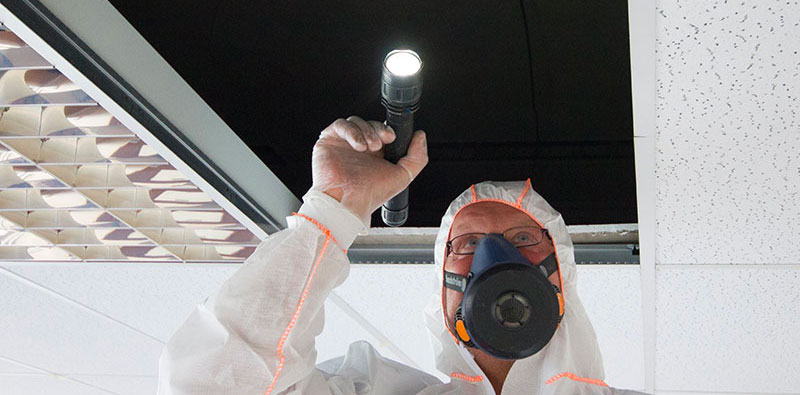Asbestos Testing: Comprehensive Assessments to Make Sure Total Security
Asbestos Testing: Comprehensive Assessments to Make Sure Total Security
Blog Article
The Full Process of Accredited Asbestos Evaluating to Make Certain Residential Property Conformity
In the world of property administration and compliance, the process of recognized asbestos testing stands as a vital part to ensure the safety and well-being of occupants. Understanding the intricate actions entailed in this screening method is extremely important for homeowner and supervisors alike. From the preliminary evaluation to the final interpretation of outcomes, each phase plays a crucial function in identifying the presence of asbestos within a property. Allow's check out exactly how this meticulous procedure unravels to ensure adherence to stringent regulations and guard versus potential wellness dangers.
Accredited Asbestos Screening: Initial Evaluation
In conducting the preliminary analysis for approved asbestos screening, a meticulous evaluation of the residential property's products is vital to properly recognize possible asbestos-containing materials. Special attention is given to materials that are prone to harm or disruption, as these scenarios can launch unsafe asbestos fibers right into the air.
Approved asbestos assessors follow strict protocols established by regulatory bodies to ensure the accuracy and integrity of the testing procedure. By diligently recording searchings for and making use of sophisticated testing techniques, assessors can supply homeowner with a comprehensive record describing the visibility of asbestos, if any type of, and the suggested steps for reduction or elimination. This preliminary assessment sets the structure for succeeding actions to address asbestos concerns and make certain the safety and security and compliance of the residential or commercial property.
Sample Collection Treatments for Asbestos Checking
Efficient sample collection treatments are crucial in guaranteeing accurate asbestos testing results and compliance with governing standards. When collecting samples for asbestos testing, it is important to adhere to stringent protocols to lessen the risk of contamination and make sure the reliability of the results.
To start with, it is crucial to recognize the thought asbestos-containing products (ACMs) and prioritize sampling locations based on aspects such as the product's condition, availability, and potential for disturbance. Asbestos Testing. Examples should be gathered from numerous locations within the residential property to provide an extensive analysis of asbestos presence
During sample collection, accredited specialists should use proper individual protective equipment (PPE) to secure versus asbestos direct exposure. They must use clean devices, such as non reusable handwear covers and plastic sheeting, to avoid cross-contamination in between examples. Examples need to be carefully collected utilizing a specified method, such as damp cleaning or coring, and firmly secured in airtight containers to preserve their integrity during transportation to the lab for evaluation.
Research Laboratory Evaluation Refine for Asbestos Examples
Upon completion of the example collection procedure, the asbestos samples are carefully transferred to certified laboratories for meticulous evaluation. The very first step in the research laboratory evaluation process is example preparation, where the accumulated examples are thoroughly refined to draw out the asbestos fibers.

As soon as the analysis is full, a comprehensive record is generated, detailing the findings and verifying whether asbestos exists, the kind of asbestos fibers recognized, and the concentration degrees. This details is critical for homeowner to take the needed actions to ensure compliance with asbestos laws and protect the health and wellness of owners.

Reporting and Interpretation of Asbestos Examination Outcomes
Certified asbestos screening research laboratories offer in-depth records that provide vital insights into the existence, kind, and focus levels of asbestos fibers discovered in samples accumulated from residential or commercial properties. These reports are essential for homeowner and managers to understand the risk presented by asbestos and make informed choices regarding its management or removal. The records commonly include information on the techniques utilized for screening, the areas where examples were taken, the sort of asbestos recognized (such as chrysotile, amosite, or crocidolite), and the focus degrees of asbestos fibers visit this site detected.
Interpreting these results requires competence to examine the possible wellness threats connected with asbestos direct exposure, figure out the proper strategy, reference and make sure regulative compliance (Asbestos Testing). Depending on the findings, recommendations might vary from proceeded tracking and maintenance to encapsulation or complete asbestos reduction. Homeowner need to meticulously assess these records and seek advice from asbestos professionals to create a comprehensive prepare for resolving any type of asbestos problems identified
Ensuring Building Conformity With Asbestos Regulations
To maintain adherence with asbestos laws, homeowner must faithfully carry out measures to make certain conformity with applicable regulations and guidelines. This consists of carrying out regular asbestos assessments by certified specialists to recognize any visibility of asbestos-containing materials within the property. When asbestos is identified, building owners have to follow asbestos monitoring plans that rundown proper control, elimination, or encapsulation procedures to stop exposure and spread of asbestos fibers. Compliance additionally involves maintaining detailed records of asbestos screening, upkeep, and removal tasks for examination purposes.
Homeowner must provide asbestos understanding training you could try this out to workers and passengers to minimize the danger of asbestos exposure and make sure correct handling of materials that may consist of asbestos. In addition, it is important to remain notified concerning any kind of updates or changes in asbestos regulations to change administration techniques as necessary. By proactively attending to asbestos conformity demands, homeowner can develop a secure setting for occupants and minimize potential legal and health and wellness risks related to asbestos exposure.
Conclusion
To conclude, certified asbestos testing is a critical procedure for ensuring property conformity with laws. The preliminary evaluation, sample collection treatments, research laboratory evaluation, and analysis of results are all crucial steps in this process. By adhering to these treatments, building owners can determine and address any asbestos threats existing, safeguarding the health and wellness of residents and maintaining conformity with regulative requirements.
Report this page